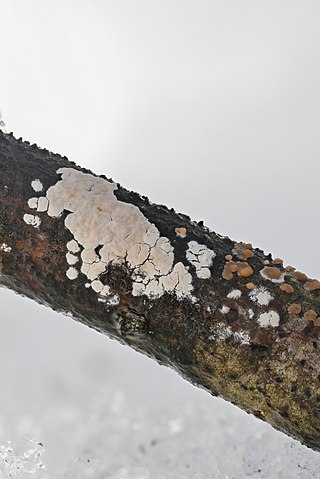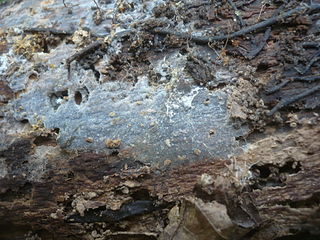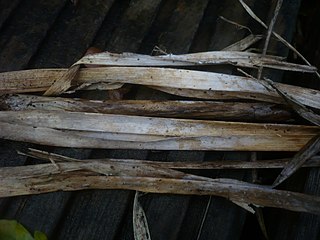
Corticium roseum is a species of fungus in the family Corticiaceae. Basidiocarps are effused, smooth, corticioid, and pink. The species has a wide, north and south temperate distribution and in Europe is typically found on dead, attached branches of Salix and Populus.

Phanerochaete is a genus of crust fungi in the family Phanerochaetaceae.

Hubert Bourdot was a French Roman Catholic priest and mycologist who was a native of Imphy, a community in the department of Nièvre.

The Phanerochaetaceae are a family of mostly crust fungi in the order Polyporales.

Tremella is a genus of fungi in the family Tremellaceae. All Tremella species are parasites of other fungi and most produce anamorphic yeast states. Basidiocarps, when produced, are gelatinous and are colloquially classed among the "jelly fungi". Over 100 species of Tremella are currently recognized worldwide. One species, Tremella fuciformis, is commercially cultivated for food.

Scopuloides is a genus of five species of crust fungi in the family Meruliaceae.

Phlebia is a genus of mostly crust fungi in the family Meruliaceae. The genus has a widespread distribution. Phlebia species cause white rot.

Corticium is a genus of fungi in the family Corticiaceae. Basidiocarps are effused, corticioid, smooth, and grow on dead wood. One species, C. silviae, is lichenicolous. The genus was formerly used in a very wide sense for almost any effused corticioid fungi.
Gloeohypochnicium is a genus of wood-inhabiting crust fungi of uncertain familial placement in the order Russulales. Originally conceived by Erast Parmasto as a subgenus of Hypochnicium, Kurt Hjortstam considered it worthy of distinct generic status in 1987. The type species, G. analogum, was described as new to science in 1913 by French mycologists Hubert Bourdot and Amédée Galzin as a species of Gloeocystidium. G. versatum was added to the genus in 2010.

Hypochnicium is a genus of corticioid fungi in the family Meruliaceae. The genus was circumscribed by mycologist John Eriksson in 1958.

Epithele is a genus of crust fungi in the family Polyporaceae.

Amaurodon is a genus of fungi in the family Thelephoraceae. Most species in the genus have resupinate and corticioid fruit bodies that grow on rotting wood. The hymenophore may have pores, teeth, or be smooth, and is typically blue to green in color.

Tomentella is a genus of corticioid fungi in the family Thelephoraceae. The genus is ectomycorrhizal, and widespread, with about 80 species according to a 2008 estimate, although many new species have since been described. Tomentella was circumscribed by French mycologist Narcisse Théophile Patouillard in 1887.

Coniophora is a genus of fungi within the order Boletales. Basidiocarps are corticioid (patch-forming). There are 20 species in the genus, which has a widespread distribution. One notable member is the cellar fungus (C. puteana), which causes wet rot in wood. Molecular analysis has revealed that there are cryptic species in the fungal lineages Coniophora olivacea, C. arida, and C. puteana.

The corticioid fungi are a group of fungi in the Basidiomycota typically having effused, smooth basidiocarps that are formed on the undersides of dead tree trunks or branches. They are sometimes colloquially called crust fungi or patch fungi. Originally such fungi were referred to the genus Corticium and subsequently to the family Corticiaceae, but it is now known that all corticioid species are not necessarily closely related. The fact that they look similar is an example of convergent evolution. Since they are often studied as a group, it is convenient to retain the informal (non-taxonomic) name of "corticioid fungi" and this term is frequently used in research papers and other texts.

Peniophora quercina is a species of wood-decay fungus in the family Peniophoraceae. It produces fruit bodies that vary in appearance depending on whether they are wet or dry. The wet fruit bodies are waxy and lilac, and attached strongly to the wood on which they grow. When dry, the edges curl up and reveal the dark underside, while the surface becomes crusty and pink. P. quercina is the type species of the genus Peniophora, with the species being reclassified as a member of the genus upon the latter's creation by Mordecai Cubitt Cooke. P. quercina is found primarily in Europe, where it can be encountered all year. Though primarily growing upon dead wood, especially oak, it is also capable of growing upon still-living wood.
Mycostigma is a genus of fungi in the family Atheliaceae. The genus is monotypic, containing the single species Mycostigma aegeritoides, found in Europe.

Amphinema byssoides is a species of corticioid fungus known to form mycorrhizal relationships with spruce trees.

Tulasnella aurantiaca is a species of fungus in the order Cantharellales. It produces orange-red, pustular, gelatinous anamorphic states on dead, deciduous wood. Originally described from Europe, it also occurs in North America where the species appears to be more common.
Oliveonia is a genus of fungi in the order Auriculariales. Species form thin, effused, corticioid basidiocarps with microscopically prominent cystidia and aseptate basidia producing basidiospores that give rise to secondary spores. All species are believed to be saprotrophic, most growing on dead wood. The genus was originally published by American mycologist L.S. Olive in 1957 as Heteromyces, but this is an illegitimate later homonym of the lichen genus Heteromyces Müll.Arg. (1889). The genus was renamed Oliveonia by Dutch mycologist M.A. Donk in 1958.















